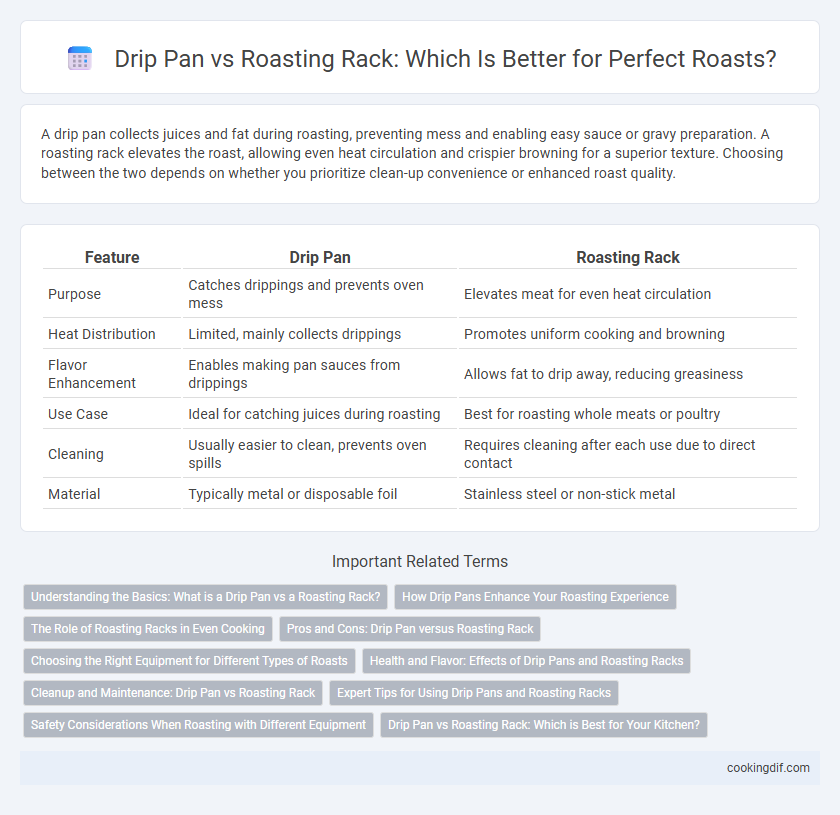A drip pan collects juices and fat during roasting, preventing mess and enabling easy sauce or gravy preparation. A roasting rack elevates the roast, allowing even heat circulation and crispier browning for a superior texture. Choosing between the two depends on whether you prioritize clean-up convenience or enhanced roast quality.
Table of Comparison
| Feature | Drip Pan | Roasting Rack |
|---|---|---|
| Purpose | Catches drippings and prevents oven mess | Elevates meat for even heat circulation |
| Heat Distribution | Limited, mainly collects drippings | Promotes uniform cooking and browning |
| Flavor Enhancement | Enables making pan sauces from drippings | Allows fat to drip away, reducing greasiness |
| Use Case | Ideal for catching juices during roasting | Best for roasting whole meats or poultry |
| Cleaning | Usually easier to clean, prevents oven spills | Requires cleaning after each use due to direct contact |
| Material | Typically metal or disposable foil | Stainless steel or non-stick metal |
Understanding the Basics: What is a Drip Pan vs a Roasting Rack?
A drip pan is a shallow tray placed beneath the roast to catch drippings, preventing flare-ups and making cleanup easier, while a roasting rack elevates the meat above the pan, allowing air circulation and even cooking. Drip pans help retain juices, which can be used for gravy, whereas roasting racks promote browning and crisping by keeping the meat out of the fat. Choosing between the two depends on whether you prioritize moisture retention or texture in your roast.
How Drip Pans Enhance Your Roasting Experience
Drip pans improve your roasting experience by capturing juices and fats, preventing flare-ups and reducing oven mess. Their design allows for even heat distribution, which ensures consistent cooking and enhances flavor by retaining moisture. Compared to roasting racks, drip pans simplify cleanup while also serving as a base for adding aromatic herbs or liquids that infuse the roast with additional flavor.
The Role of Roasting Racks in Even Cooking
Roasting racks play a crucial role in ensuring even cooking by elevating the meat above the drip pan, allowing hot air to circulate uniformly around the roast. This elevation prevents the meat from sitting in its juices, which can lead to steaming instead of roasting, resulting in a crispier exterior and juicier interior. Unlike drip pans that collect drippings for sauces, roasting racks contribute significantly to texture and doneness by promoting balanced heat exposure.
Pros and Cons: Drip Pan versus Roasting Rack
A drip pan catches fat and juices, preventing oven mess and enabling sauce or gravy creation, but it can limit heat circulation and result in a less crispy roast exterior. A roasting rack elevates the meat, allowing even heat circulation for a crispier crust and more uniform cooking, though it requires more cleanup and may cause juices to drip directly onto the oven floor if not properly positioned. Choosing between a drip pan and roasting rack depends on prioritizing easier cleanup and moisture retention versus enhanced airflow and roast texture.
Choosing the Right Equipment for Different Types of Roasts
Selecting the appropriate roast equipment depends on the type and desired outcome of the roast, with drip pans ideal for capturing juices and preventing flare-ups during high-fat roasts like pork or poultry. Roasting racks elevate the meat, allowing hot air to circulate evenly, which is essential for roasting large cuts like beef prime rib or whole chickens to achieve a crisp exterior and uniform cooking. Understanding the differences between drip pans and roasting racks ensures optimal flavor retention and texture based on the roast type and cooking method.
Health and Flavor: Effects of Drip Pans and Roasting Racks
Roasting racks elevate meat, allowing fat to drip away, resulting in a leaner, healthier roast with crispy edges due to better air circulation. Drip pans catch the drippings, preventing flare-ups and enabling the collection of flavorful juices for sauces, enhancing the roast's taste. Choosing between a drip pan and roasting rack affects the balance between fat reduction and flavor retention in roasted dishes.
Cleanup and Maintenance: Drip Pan vs Roasting Rack
A drip pan catches grease and food drippings, minimizing mess and simplifying cleanup by containing liquids that can otherwise char on the oven floor. Roasting racks elevate the meat, allowing fat to drip away but often require more detailed cleaning due to food residue stuck on the bars. Drip pans are generally easier to clean and maintain, while roasting racks may need scraping and soaking to remove baked-on debris effectively.
Expert Tips for Using Drip Pans and Roasting Racks
Using a drip pan helps collect excess fat and juices during roasting, preventing flare-ups and simplifying cleanup while enhancing oven hygiene. A roasting rack elevates the meat, allowing even heat circulation and optimal browning, which results in a juicier roast with a crisp exterior. Experts recommend combining both tools by placing a roasting rack inside a drip pan to capture drippings for gravies and reducing smoke in the oven.
Safety Considerations When Roasting with Different Equipment
Using a drip pan during roasting helps prevent grease fires by catching fat and juices, reducing the risk of flare-ups in the oven. Roasting racks elevate the meat, promoting even heat circulation but require careful placement to avoid tipping and spilling hot liquids. Properly choosing and positioning drip pans and roasting racks enhances safety by minimizing direct contact with flames and stabilizing the roasting setup.
Drip Pan vs Roasting Rack: Which is Best for Your Kitchen?
A drip pan collects juices and prevents messes during roasting, making cleanup easier and protecting oven surfaces from spills. Roasting racks elevate the meat, allowing air circulation for even cooking and crispier texture by preventing the roast from sitting in its own juices. Choose a drip pan for mess control and roasting racks for optimal heat distribution and browning; some setups combine both for maximum efficiency.
Drip Pan vs Roasting Rack for roast equipment Infographic

 cookingdif.com
cookingdif.com